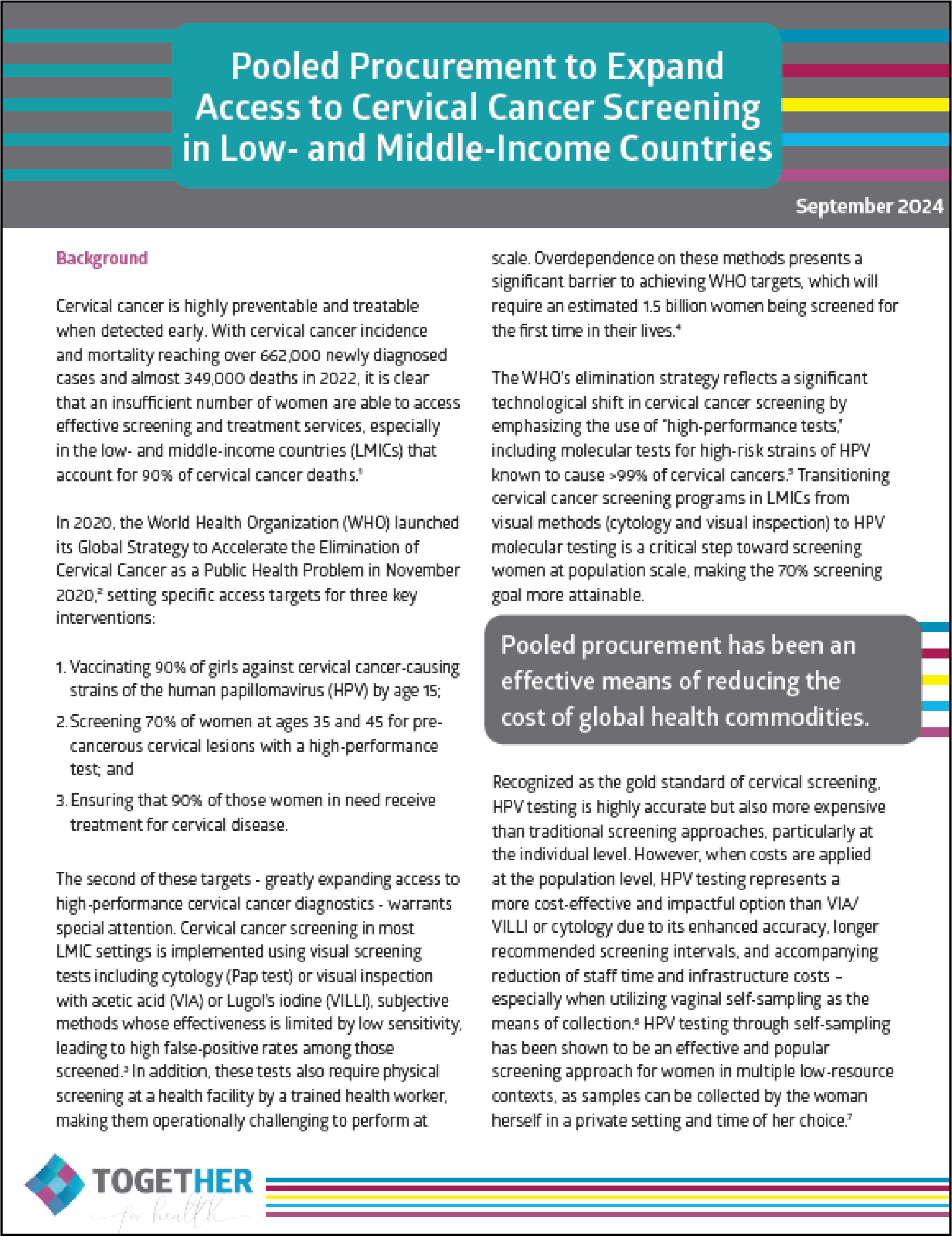New TogetHER Publication Explores Pooled Procurement’s Potential to Increase Access to Cervical Cancer Screening
An Executive Summary of this report is now available. Click here to access.
Can Pooled Procurement Mechanisms Get Us Closer to Cervical Cancer Elimination?
September 26, 2024
Cervical cancer elimination is an achievable goal that hinges on getting women access to proven prevention interventions: HPV vaccination, high-performance screening, and timely treatment. But access itself depends heavily on the affordability and the availability of these interventions in a region.
Molecular diagnostics for HPV have proven to be far more accurate than more widespread visual methods such as cytology and visual inspection with acetic acid, while also requiring less frequent screening and reducing the burden on health practitioners, especially when deployed through self-testing. However, this newer technology has seen slow uptake in low-resource settings in part due to the high need for investment in testing platforms and the relatively high price of individual tests.
Pooled procurement mechanisms have been essential to negotiating reduced prices and expanding the supply of global health commodities on behalf of low- and middle-income countries. Cervical cancer elimination efforts have greatly benefited from the pooled procurement of HPV vaccines by UNICEF on behalf of Gavi, the Vaccine Alliance, reducing vaccine prices to a fraction of those in high-income countries and ensuring their widespread global introduction and distribution. Such investments will protect today’s young women from cervical cancer – and other HPV-related cancers. But it’s just as critical to ensure that adult women today have access to lifesaving screening giving those at highest risk a pathway to necessary care.
To understand how pooled procurement might be leveraged to reduce the cost of HPV tests in low- and middle-income countries, TogetHER for Health undertook a formative research project combining desk research with interviews of stakeholders representing HPV diagnostics manufacturers, cervical cancer program implementers, and organizations specializing in global health procurement. We’re proud to release the results of this project as well as this brief Executive Summary in order to inform decision makers and advocates interested in advancing cervical cancer elimination efforts.
Some key insights from our findings:
- Stakeholders emphasized that sustainable, predictable funding is key to any successful pooled procurement, providing the necessary incentive for suppliers to commit volumes of health commodities and in turn to negotiate price reductions.
- Reliable demand forecasting was seen by stakeholders as critical to substantiating the case for pooling resources and ensuring the necessary supply.
- Expanding the eligibility of pre-existing pooled mechanisms to include HPV diagnostics may be preferable to the creation of one dedicated solely to their purchase, given the effort and investment needed to launch a new pooled mechanism.
- Reducing the price of HPV tests and increasing their supply can amplify the impact of investments and support higher cervical cancer screening rates, but ultimately these only represent one part of a complex process necessary to screen and, if necessary, treat women.
TogetHER for Health hopes this new publication proves useful to generate awareness and spark meaningful dialogue towards making HPV tests more widely affordable and accessible. We are indebted to the stakeholders who provided their time and perspectives to generate this piece, and to the reviewers who added essential insight and guidance. We look forward to supporting decisive action to broaden access to high performance screening for women around the world.
Correction, October 3rd, 2024. The originally published version of the report stated erroneously that “Cervical cancer screening in most LMIC settings is implemented using visual screening tests including cytology (Pap test) or visual inspection with acetic acid (VIA) or Lugol’s iodine (VILLI), subjective methods whose effectiveness is limited by low sensitivity, leading to high false-positive rates among those screened.” The updated version linked on this page correctly notes that visual methods such as VIA and VILLI have higher false-negative rates. TogetHER apologizes for any confusion.

